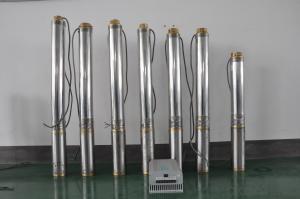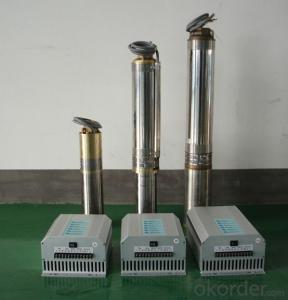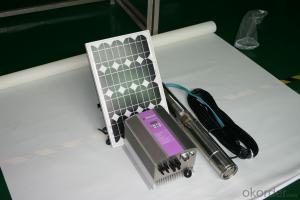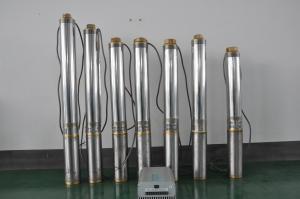Solar pump inverter FCPM1100L
- Loading Port:
- China Main Port
- Payment Terms:
- TT OR LC
- Min Order Qty:
- -
- Supply Capability:
- -
OKorder Service Pledge
Quality Product, Order Online Tracking, Timely Delivery
OKorder Financial Service
Credit Rating, Credit Services, Credit Purchasing
You Might Also Like
Solar pump inverter FCPM1100L Product Description:
Solar water pumping system is constructed with solar panel array,solar pump inverter and AC water pump, DC current produced from solar panel will be delivered to solar pump inverter,and it will convert it into AC current to drive water pump,and will automatically regulate output frequency according to sun radiance intensity,maximally realize MPPT tracking function.
Features
Adopting the proposed dynamic VI maximum power point tracking (MPPT) control method, with fast response, and reliable operation, achieves efficiency of 99%.
Designed with variable frequency driver, greatly improves efficiency
Extremely high efficiency
Digital mode control, with automatic operation and manual operation mode options
Complete protection functions
Adopts intelligent IPM module, with high reliability
LCD display and operation panel, in real time presents operating data
Optional for water level measurement and control circuit
Applicable for general ACC pumps, like centrifugal pump, piston pump etc.
Independent intellectual property; Highly effective, the redundant reliability, exempts the maintenance and the long life.
The pumps are soft started, fully protected.
No batteries are used. So better Sunlight, more water.
Datasheet.
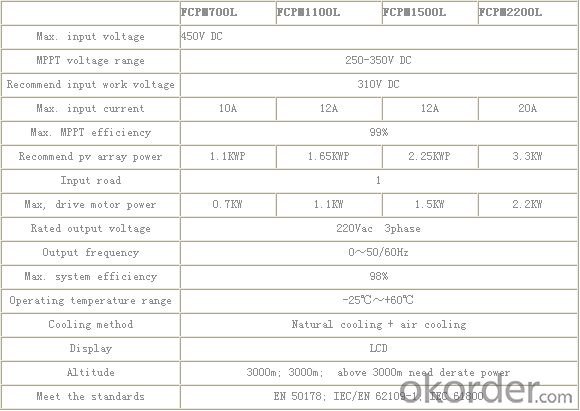
- Q:How do I determine the water requirements for my application?
- In order to determine the water requirements for your application, there are several factors that need to be taken into consideration. Firstly, it is important to assess the specific needs of your application. It is necessary to determine the quantity of water required for each process or task involved. This may include tasks such as cleaning, cooling, or mixing. The next step is to evaluate the water quality that is needed for your application. Depending on the processes involved, some applications may require purified or distilled water, while others may be suitable for regular tap water. Understanding the required water quality will help in identifying the necessary treatment or filtration processes. The water pressure and flow rate required for your application should also be considered. Certain processes may require high-pressure water jets or a continuous flow of water. It is crucial to ensure that the water supply can meet these specific requirements. Furthermore, it is important to assess the availability and accessibility of water in your location. Factors such as the water source, its availability throughout the year, and any restrictions or regulations related to water usage in your area should be taken into account. Considering the environmental impact of your water usage is also essential. It is necessary to evaluate and implement sustainability and conservation measures to minimize wastage and reduce the overall water footprint of your application. Lastly, consulting with experts or professionals in the field is highly recommended. Their experience and knowledge can provide valuable guidance in determining the specific water requirements for your application and suggest any necessary equipment or technologies to meet those requirements. By taking into account these factors and seeking expert advice, you can effectively determine the water requirements for your application and ensure that you have a sufficient and sustainable water supply.
- Q:How does the performance of a solar pump vary with different pumping distances?
- The performance of a solar pump can change depending on the distance it needs to pump. When the pumping distance increases, the solar pump's performance may decrease due to various factors. One of the main factors that affects a solar pump's performance at different pumping distances is the vertical distance or head height that the water needs to be lifted. The higher the head height, the more energy the pump needs to lift the water, which can result in reduced performance. Solar pumps have a maximum head height they can reach, and exceeding this limit can lead to a decrease in flow rate and efficiency. Moreover, the distance between the pump and the water source can also impact its performance. As the pumping distance increases, there can be friction losses in the pipes, which can cause a decline in performance. The longer the distance, the more significant these friction losses become, resulting in reduced flow rate and efficiency. Furthermore, the size and capacity of the solar pump also contribute to the variation in performance. Different pumps have different power ratings and flow rates. It is crucial to choose a pump that can efficiently handle the required flow rate and head height when selecting a solar pump for a specific pumping distance. It is essential to consider that the performance of a solar pump can also be affected by other factors such as the quality and condition of the solar panels, the amount of sunlight available, and the overall system design. Therefore, it is recommended to consult with a solar pump expert or supplier to determine the most suitable pump for a specific pumping distance, ensuring optimal performance.
- Q:Can solar pumps be used for firefighting or emergency water supply?
- Yes, solar pumps can be used for firefighting or emergency water supply. They are efficient and reliable, providing a sustainable solution for pumping water in remote areas or during power outages. Solar pumps can be deployed quickly, making them ideal for emergency situations where immediate access to water is crucial for firefighting or other emergency response needs.
- Q:Can a solar pump be used in areas with limited access to water treatment facilities?
- Yes, a solar pump can be used in areas with limited access to water treatment facilities. Solar pumps are particularly beneficial in remote or off-grid locations where there may be limited infrastructure for water treatment. They can draw water from natural sources such as wells, rivers, or lakes and provide a sustainable solution for accessing clean water without relying on traditional water treatment facilities. Additionally, solar pumps are environmentally friendly and cost-effective, making them well-suited for areas with limited resources or infrastructure.
- Q:How does the installation complexity of a solar pump compare to a traditional electric pump?
- Compared to a traditional electric pump, a solar pump is generally less complex to install. This is primarily because solar pumps do not require an elaborate electrical setup or a connection to the power grid. Solar pumps utilize photovoltaic panels to convert sunlight into electricity, which is then utilized to power the pump. The installation process typically involves placing the solar panels in a location that receives optimal sunlight exposure and ensuring a secure mounting system. The panels are then connected to the pump, often through a controller or inverter that regulates the flow of power. In contrast, traditional electric pumps necessitate a dedicated power source, usually obtained from the electrical grid. This involves more intricate electrical wiring and connections. It may also require the assistance of an electrician to correctly install the pump and ensure compliance with local electrical codes. Additionally, traditional electric pumps often require a substantial amount of infrastructure, such as power lines and transformers, which can contribute to the complexity of the installation. Furthermore, solar pumps are generally more modular and portable in comparison to traditional electric pumps. This allows for easier installation and relocation if necessary, without the need for extensive rewiring or modifications to the infrastructure. Overall, thanks to the simplicity of the solar power system and the absence of reliance on the electrical grid, the installation complexity of a solar pump is generally lower than that of a traditional electric pump.
- Q:Are solar pumps suitable for use in mountainous regions with varying elevation?
- Yes, solar pumps are suitable for use in mountainous regions with varying elevation. Solar pumps are versatile and can be installed in different terrains, including mountainous areas. They are powered by solar energy, making them independent of electricity grids, which is particularly advantageous in remote regions. Additionally, solar pumps can adjust their pumping capacity based on the available sunlight, making them adaptable to the varying elevation and sunlight conditions of mountainous regions.
- Q:What is the expected impact of shading on the performance of a solar pump?
- The expected impact of shading on the performance of a solar pump is a reduction in its efficiency and output. Shading can block sunlight from reaching the solar panels, which provide the energy to power the pump. As a result, the pump may not receive enough energy to function optimally, leading to decreased water pumping capacity. It is important to minimize shading to maximize the performance of a solar pump.
- Q:Can a solar pump be used in areas with high levels of fluoride in the water?
- Yes, a solar pump can be used in areas with high levels of fluoride in the water. Solar pumps are primarily used to lift water from a source, such as a well or a borehole, and are not directly affected by the quality or composition of the water being pumped. However, it is important to note that a solar pump alone cannot remove or reduce fluoride levels in water. Additional water treatment methods may be required to address high fluoride concentrations if necessary.
- Q:Can a solar pump be used for water supply in schools or community centers?
- Yes, a solar pump can definitely be used for water supply in schools or community centers. Solar pumps are a reliable and sustainable solution for water supply as they use solar energy to pump water from wells, rivers, or other sources. They are particularly suitable for areas with limited access to electricity or unreliable power supply. Solar pumps are easy to install, operate, and maintain. They do not require fuel or electricity to function, making them cost-effective and environmentally friendly. This also ensures that they can be used in remote locations without access to grid electricity. In schools or community centers, solar pumps can be used to provide a reliable water supply for various purposes such as drinking, sanitation, and irrigation. They can pump water to storage tanks, ensuring a continuous and clean water supply for the community. Furthermore, solar pumps can be integrated with other water treatment systems such as filtration or purification units to ensure the water supplied is safe for consumption. This makes them an ideal solution for addressing water scarcity and improving access to clean water in schools and community centers.
- Q:How does the angle of incidence of sunlight affect the performance of a solar pump?
- The angle of incidence of sunlight directly affects the performance of a solar pump. When the angle of incidence is perpendicular to the surface of the solar panel, the pump receives maximum solar energy, resulting in optimal performance and maximum water pumping efficiency. As the angle deviates from perpendicular, the amount of solar energy reaching the solar panel decreases, leading to reduced performance and lower water pumping efficiency. Hence, the angle of incidence of sunlight plays a crucial role in determining the effectiveness and output of a solar pump.
1. Manufacturer Overview |
|
|---|---|
| Location | |
| Year Established | |
| Annual Output Value | |
| Main Markets | |
| Company Certifications | |
2. Manufacturer Certificates |
|
|---|---|
| a) Certification Name | |
| Range | |
| Reference | |
| Validity Period | |
3. Manufacturer Capability |
|
|---|---|
| a)Trade Capacity | |
| Nearest Port | |
| Export Percentage | |
| No.of Employees in Trade Department | |
| Language Spoken: | |
| b)Factory Information | |
| Factory Size: | |
| No. of Production Lines | |
| Contract Manufacturing | |
| Product Price Range | |
Send your message to us
Solar pump inverter FCPM1100L
- Loading Port:
- China Main Port
- Payment Terms:
- TT OR LC
- Min Order Qty:
- -
- Supply Capability:
- -
OKorder Service Pledge
Quality Product, Order Online Tracking, Timely Delivery
OKorder Financial Service
Credit Rating, Credit Services, Credit Purchasing
Similar products
New products
Hot products
Hot Searches
Related keywords










